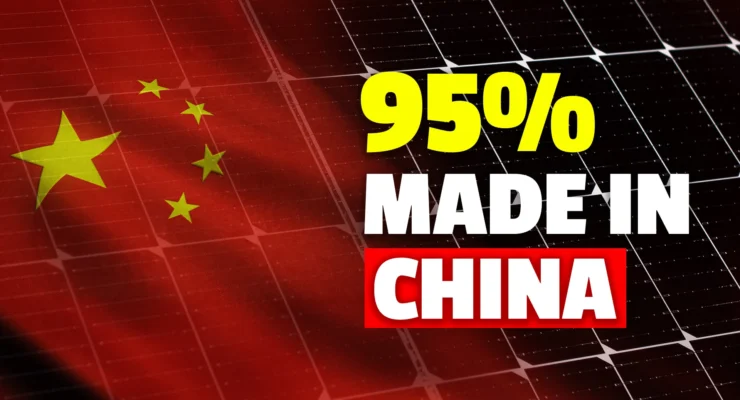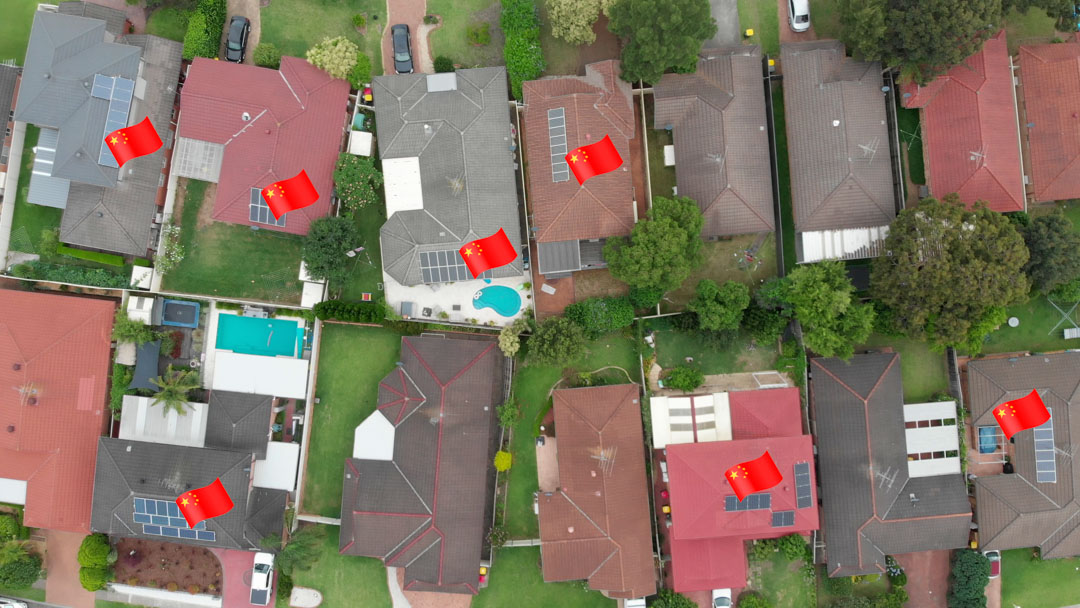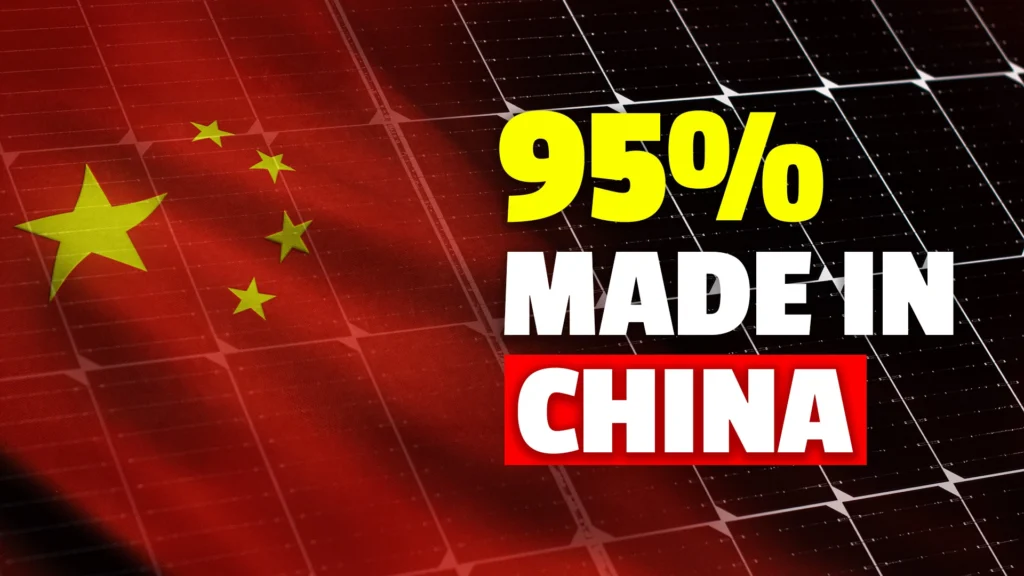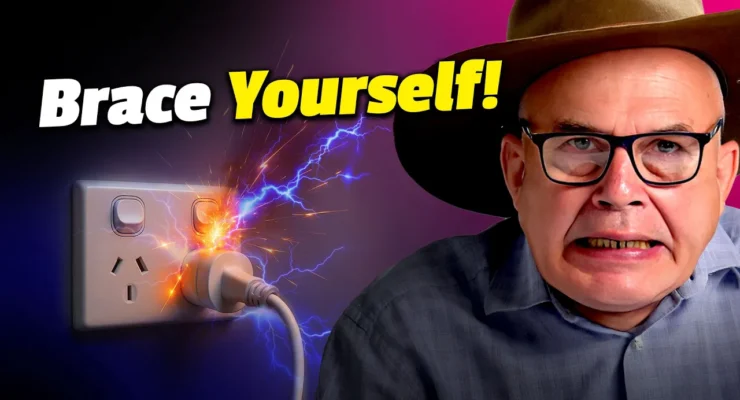
Fast read
In this program, Markus Lambert and Jono the Journo discuss the renewable technology sector's reliance on Chinese manufacturing.
Markus points out that China dominates the renewable energy industry, with about 95% of solar panels in Australia made in China. Despite China's past reputation for producing low-quality products, the reality is that the country is leading the green revolution due to their improvements in product quality, its low cost of production and its extensive distribution infrastructure.
They explore the historical perspective, comparing China's current reputation to Japan's reputation for low-quality goods after WWII, which has since shifted to a reputation for premium products.
The program also addresses anti-Chinese sentiments and urges viewers to focus on quality and after-sales service rather than solely on price. Despite the perceived dominance of China, the program encourages the audience to support renewable energy for a greener future and recommends purchasing quality renewable products from reputable local installers and of quality, wherever the place of manufacture. This means NOT to go for the cheap and cheerful product.
Where are many renewable technology products made?
Markus Lambert: We’re here at the Smart Energy Event, and I see a lot of shiny products on the walls. What I’m curious about is where these products are made. It seems to me that the renewable industry is, at the moment, very much dominated by one country China.
Jono: I am Jono the Journo. After that experience at the Smart Energy Conference, Markus and I thought to ourselves, Just how reliant are we on the Chinese renewable energy industry? After looking at the stats, it’s pretty clear how dominant of a force China really is in the renewable energy sector.
So, Markus, give us the facts
Markus Lambert: Well, as of 2022 in Australia, we now have about 3 million solar systems on roofs. When you do a quick calculation, take commercial panels into account, that’s about 80 million panels. Now about 95%, 75 million panels, are made in China. When you take into account the cost of the panels says about $15 billion worth of imports in Chinese solar panels, achieving a lot of billions in Australian solar rebates.
So in comparison, there might be around $100 million worth of solar panels made in Australia in that period. But even those panels there couldn’t keep the Chinese influence away because their cells, the glass, and the frames, in most cases were also made in China. It’s just assembled here.

Jono: So you’re telling me nine out of ten Australians basically have a Chinese flag on their roof? I think it’s time for me to learn Mandarin.
Although Chinese manufacturers in general, seem to have a bad rep for making cheap, low-quality, crappy and often fake products. But is this true for solar? That’s the real question. When we hear the words made in China, there is an uneasy feeling in the pit of our tummy.
Markus Lambert: And if this feeling gives you flashbacks, well, then you’re right.
Because after World War II, anybody who still remembers it – Japan, manufacturing technology boomed to such an extent that in the sixties and seventies, made in Japan, equal cheap electronics and motorbikes. You know, I remember the transistor radios of this vintage type radio- they were made in Japan. People didn’t expect them to last too long.
Is Markus living in the past?
Jono: Markus, you are always living in the past. Now we have trusted brands like Toyota, Lexus, Honda, Subaru, Canon, and many more known for their incredible reliability and quality. Oh, and how could I forget the PS5, of course?
Today, those items made in Japan are considered the upper echelon of premium goods. I mean, just look at this study showing the most respected made-in labels. Not bad Australia. We’re in the top 15 list, scoring 75% in consumer perception compared to China, which doesn’t even rate 30% while the Germans, of course, still ranked supreme when it comes to automotive. It’s a shame we’re not making them ourselves anymore.
Markus Lambert: Yes, you’re right. But it wasn’t always like that. About a decade ago, the Germans were really dominating solar manufacturing worldwide. SolarWorld. Solon, Conergy, Bosch. Their products dominated the Australian solar landscape, together with local manufacturing in Homebush via BP Solar. That’s where the panels came from. Hardly any Chinese in sight. But then the Chinese started their mass production drive.
As someone in the Politburo probably discovered, renewables will be the future and renewables will allow us to influence geopolitics.
So with large state subsidies in Australia, a technology from the University of New South Wales sold to China, the Germans were pushed out of energy, bankrupt, SolarWorld bankrupt, Conergy went and German manufacturers all went kaput. Auf widersehen.
And all of this benefited one country greatly. And guess which country that was? China.

China is becoming a renewable energy powerhouse
You know you’re up against the big player when the Germans call time out. The Chinese panel manufacturers simply kept on increasing production capacity and flooded the market, which meant lower-end consumer costs. And as they got Chinese government loans with no interest and the Germans had to be on a level playing field, the Germans had no chance.
For the last 20 to 30 years, the West has profited from cheap Chinese labour in producing goods, and now China is well equipped in the production line to produce its own brands at half the price. And this only means one thing for Australians. And what’s that Jono?
Jono: Cheaper solar systems, and there isn’t a single person complaining about that.
Markus Lambert: China is actually saving our planet, and it’s the Chinese policies which made local solar owners’ energy bills go down. But no one talks about that.
But back to Japan, moving from unreliable products to reliable products. When it comes to China, this perception is currently the complete opposite with the words cheap and unreliable, being a representation of many people’s thoughts about made in China. They buy it, but they still don’t really trust it.
But in reality, China continues to innovate and now produces high-quality products when it comes to solar panels, inverters and even home batteries. So the reality is China right now leads the Green Revolution simply because of the lower cost of their products and distribution infrastructure.
As the world will need more and more renewable products to avoid catastrophic climate change, Chinese economic power and influence will also increase due to renewable domination. They played a smart game. We are now the boiling frogs.
What does Chinese domination mean for renewables?
However, anti-Chinese sentiment still exists with a clash of different political ideologies. Global momentum to tackle climate change and the constant media bombardment on the ever-growing threat of world domination. It’s no wonder the Chinese reputation in the West is currently as low as it comes.
Jono: But the real question we need to be asking is what does this mean for our renewable energy sector At a local level? Well, what it does mean is that there is a hesitation to admit that products are made in China due to a fear that it might lower the brand’s reputation.
Overwhelming fear is associated with Chinese products. But the truth is, just because it is made in China does not mean that it is low quality or comes with extra secret Chinese spies. It’s very simple. If you buy a cheaper product, it doesn’t matter where it’s made, it’s so much more likely to be a lower-quality item.
In reality, Made in China comes down to a very simple fact. You pay for what you get. Just like when you buy an iPhone, you pay a premium price for a brand that is known for high-quality standards and after-sales support. Even though it comes with the tagline Made in China. This is the same with buying renewable tech like solar panels, where there are also differences in price and quality.
Not only has China become more effective at producing goods globally, but they have developed just mesmerizing culture of excellence at producing quality goods. And it’s so much more difficult for other nations to outcompete China. In fact, the Chinese labour technique can be encapsulated in three words efficiency, dedication and efficiency, especially when compared to other parts of the world.

Here are some more fun stats for you
A whopping 89% of people in the Western world believe we should rely less on Chinese imports. Yet only 14% know that their panels were in fact made in China. If people have to make a choice between buying a convenient product from Kmart or IKEA versus what they distaste for Made in China, the cheaper product almost always wins out.
So maybe we are just a bunch of tight-arse hypocrites. China is not only growing as a global superpower in renewable trade but is at the point where they are now the world’s largest clean energy investor. They have spent over 83 billion USD in 2019 alone, becoming so much more energy-independent from the old dinosaur juices of the past.
China has created football fields worth of solar panels every hour in only ten years. They moved from producing a mere 800 megawatts to where they now produce 2200 gigawatts. In 2015 alone, China installed more than one wind turbine. Not every week and not every day, but every hour. Every day for the entire year. China graduates above 600,000 engineers annually, whereas the US in all its glory, graduates a mere 70,000.
China is going to outcompete in engineering the rest of the world. We all really need to ask ourselves, how are we going to catch up? How are we going to be an active contributor to the global shift towards a greener world?
China is doing well
Think about it like this. If the renewable energy industry were a soccer game, central planning and state-sponsored industries, for example, our good old friend China is way ahead.
It’s four goals versus nil. The democratic capitalist system is losing because at the moment the future of energy is not green at all. It’s red. We need to encourage the Western world to pioneer the green energy revolution and catch up to China.
Perhaps it really isn’t about which team we are on as long as we are all on Team Planet. So, Markus, let the people know. Let’s all be involved in the shift to a better, greener future.

Markus Lambert: A couple of steps you can take is to purchase quality products from a reputable brand with an established office here in your local area. Don’t just go with a flashy sales company. Go with a local installer, and don’t only decide on price, but also after-sales, service and long-lasting aspects of the actual product. Consider the size of the company.
How long have they been in operation, both manufacturer and installer? Check out their reviews and most importantly, the product warranty consideration.
Thanks to the World Wide Web you can do your diligent research and look for these key signs to help you make the better decision. Or you can simply check out our website where we have tons of great renewable product information.
Find the best quotes, and the best installers in your area to get a decade-long lasting system and terrific financial returns.
Final words
Jono: Thanks for tuning in. Please leave us a comment and let us know your thoughts on the Made in China program.



